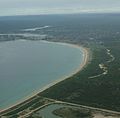Wanda Beach | |
|---|---|
Beach | |
 View of Wanda Beach looking east towards Bate Bay | |
 | |
| Coordinates: 34°02′36″S151°09′43″E / 34.04333°S 151.16194°E | |
| Location | Cronulla, Sydney, New South Wales, Australia |
| Dimensions | |
| • Length | 1500 m |
| Patrolled by | Wanda Surf Life Saving Club |
| Hazard rating | 7/10 (highly hazardous) |
| Designations | |
|---|---|
| Official name | Cronulla Sand Dune and Wanda Beach Coastal Landscape |
| Type | Landscape – Natural |
| Criteria | a, b, c, d, e, f, g |
| Designated | 26 September 2003 |
| Reference no. | 01668 |
Wanda Beach or Wanda is the northernmost patrolled beach at Bate Bay in Cronulla, Sydney, New South Wales, Australia. [1] Green Hills or Green Hills Ridge is the name given to the Cronulla sand dunes, just north of Wanda. [2]




